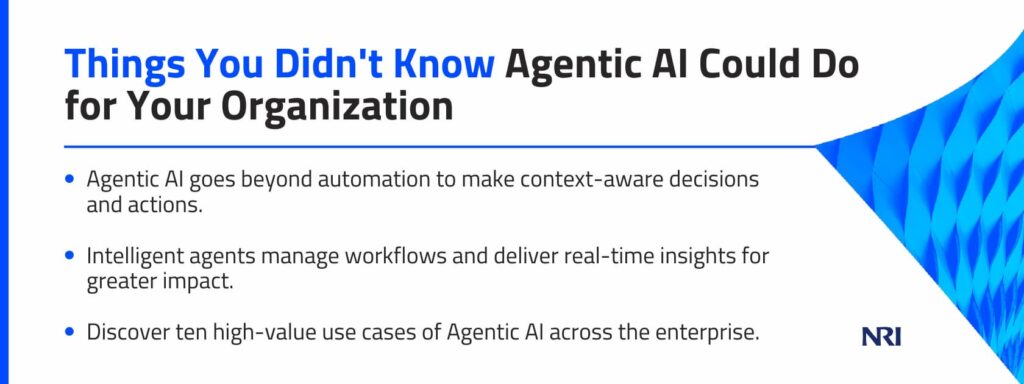The age of AI that proactively solves your most significant challenges without waiting for instructions is upon us. Here are 10 surprising real-world use cases.

Over the last few years, and most notably with the launch of OpenAI’s ChatGPT, generative AI has gained significant attention in business and technology circles. More recently, however, agentic AI has crept in, promising to combine the precision of traditional programming with the flexibility and versatility of large language models (LLMs) to unlock new capabilities.
Simply, AI agents are systems capable of autonomous behavior and independent decision making. They can reason, plan, act, learn relationships and patterns, and modify strategies in real-time to optimize outcomes. This represents a significant step beyond traditional AI, which relies on instructions and predetermined pathways to achieve its objectives.
According to Mordor Intelligence, organizations have spent over $7 billion on agentic AI capabilities as of 2025. That figure is expected to grow at a 41.48% compound annual growth rate (CAGR), reaching $41 billion in 2030. The rising adoption coincides with increasing complexity in enterprise IT landscapes, mounting regulatory pressures, and the need for rapid innovation, all of which agentic AI can help solve. Now more than ever, leaders must consider how agentic AI fits into their enterprise AI strategies and move fast to capture benefits.
Here are 10 surprising agentic AI use cases.
1. Intelligent Escalation in IT Service Management
One promising area to leverage agentic AI is in improving service desk efficiency. Here, you can use agents to classify, prioritize, and escalate tickets. Instead of relying on static rules, you can have the agents analyze ticket metadata, system telemetry, and service-level agreements (SLAs) in real-time to route incidents based on urgency and your team’s workload and availability. Agents can even take the first remediation steps before escalating the issue to someone on your team. Organizations using this model have demonstrated reductions of up to 40% in resolution time.
2. Autonomous Policy Enforcement and Compliance Checks
As you know, maintaining regulatory compliance can be quite resource-intensive. This is yet another area where agentic AI can help through continuous monitoring and real-time remediation of compliance violations. For instance, you could deploy agents to independently scan your access controls or cloud configurations, revoke unauthorized changes, and document actions for audit purposes.
3. Smart Contract Negotiation
Another interesting application of agentic AI is the end-to-end negotiation of contracts. One Estonian startup, Pactum, provides global companies, such as Walmart, Maersk, and Vodafone, with autonomous AI agents to negotiate deals with suppliers. These agents analyze historical and market data to propose terms, handle counteroffers, and finalize agreements with other bots on the other side of the table. Are you ready for this new era of autonomous dealmaking?
4. Adaptive Employee Onboarding
Agentic AI can also help streamline the onboarding experience by guiding new hires through setup, training, and HR policies. Here, you can deploy it to handle form submissions, provision accounts, and answer FAQs. Adaptive employee onboarding using AI agents provides a more consistent and timely experience for new hires, while also minimizing the administrative burden on your HR and IT support teams.
5. Self-Healing Infrastructure and Predictive Maintenance
In IT operations, agents can proactively monitor logs, system health indicators, and workload patterns to detect anomalies and take corrective actions, such as restarting services, rebalancing resources, or rolling back deployments. They could also alert you to those maintenance tasks requiring your team’s input. Ultimately, this translates to less downtime and higher system resilience.
6. Dynamic Personalization in Internal Tools
Your internal apps don’t have to be one-size-fits-all. Agentic AI can tailor experiences based on roles, past behaviors, and user intent. For instance, an agent embedded in a knowledge base can personalize content recommendations by remembering an employee’s job, issues, and location.
7. Agent-Based Knowledge Curation and Documentation
Another application is streamlining internal wikis. You can deploy an AI agent to act as an internal editor for tasks such as summarizing meeting transcripts, linking relevant policies, updating new information, or retiring outdated content. That way, your internal knowledge ecosystem stays sharp and searchable.
8. Intelligent Threat Triage
Overwhelmed by security management and several false alerts? Agentic AI can give you an edge by automating threat detection, triage, and response workflows. For instance, IBM’s QRadar Security Suite utilizes advanced AI analysis to filter out false alerts, then automatically initiates an investigation for verified threats, tackling high-priority incidents first. As a result, alert triage timelines are slashed by 55% and mean time to resolution also sees a significant boost.
9. Strategic Planning
Beyond operational workflows, agentic AI can be applied to strategic functions such as financial forecasting, workforce planning, and scenario simulation. Here, agents can analyze internal data sources, identify trends, and generate decision-support insights for leadership teams. Salesforce Agentforce is one such initiative, allowing enterprises to build agents that evaluate real-time KPIs and suggest adaptive business strategies aligned with evolving market conditions.
10. Cross-System Coordination
Finally, agentic AI can coordinate workflows across systems without hardcoded integration. Using frameworks such as LangChain, Anthropic’s Model Context Protocol, or event-driven platforms like Kafka, agents can orchestrate tasks across CRM, ERP, service desk, and custom applications on demand. This functionality can help you reduce dependency on middleware and manual API orchestration, allowing for more agile and responsive enterprise architectures.
Maximizing Impact with the Right Framework
Agentic AI is the next leap in enterprise automation, and these 10 examples are just a glimpse of what’s possible. That said, success in deploying agents for various business applications hinges on using the appropriate framework. It also requires developing a culture of readiness, characterized by a balanced risk management approach, robust processes, and openness to change. Despite the workforce, data, security, and regulatory challenges posed by agentic AI systems, there’s immense potential for new efficiencies and innovation.
Are you currently evaluating how to leverage agentic AI in your enterprise? Reach out to our team to discover practical use cases and the path to accelerate adoption.



